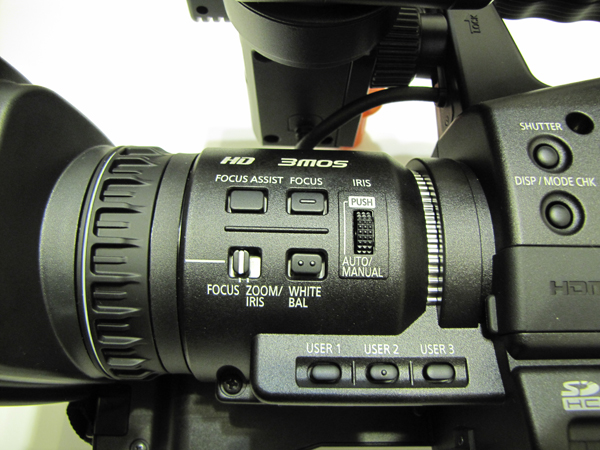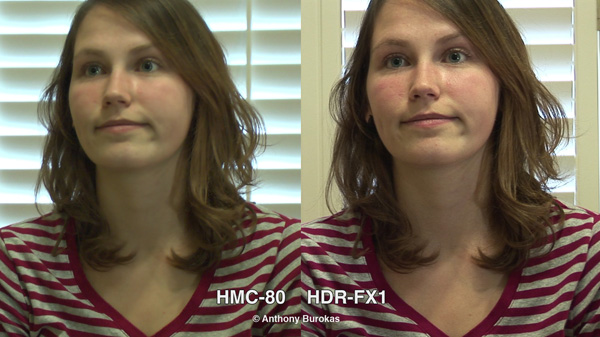Review: Panasonic AG-HMC80 Shouldermount Camcorder
In an era of ever-shrinking HD cameras, cell phone HD, and DSLRs, you might ask, why would anyone need an on-shoulder HD camcorder? Is it the copious amount of I/O jacks? The ergonomics? Or the easy access to numerous features in a big camera sort of way that enamor the Panasonic AG-HMC80 to its target end users? Let's find out.
USAGE
The HMC80 powers up quickly, and I was able to start recording in under 4 seconds. General ergonomics of the camera are good, but those coming from the professional realm will find that this camera takes a bit of getting used to.
There's no record or white balance under the lens. Actually, there's nothing there. There's only one lens "ring" and it can either focus, or provide zoom/iris duty (zoom or iris is selectable in the menu). Since the zoom is servo only, and moves no faster with the ring than the zoom rocker, I set it to iris. It's far easier to use than the tiny little iris dial on the side of the lens.

Focus Assist, Zoom, and Iris controls
I tried using the ring to focus, both in manual and in auto modes, and it works well. This is handy if you're using auto focus but the camera has focused on the background; you can just rotate the ring and pull your focus to the subject. The menu has an option for face framing- which sounds like the "face auto detect" used in still cameras. This would be a great feature to indicate to me which face the camcorder is using to focus on but I never saw anything around faces in the viewfinder.
The built-in speaker is a welcome addition for anyone not used to having one. This way, you can hear the audio while you shoot because there's a small speaker built into the camcorder, right next to your ear. In the menu you can select which channel you hear, or both. This also applies to the headphone out. But unlike using headphones, you are not tethered to the camera.
FORMATS
As with most HD camcorders these days, the HMC80 records in myriad formats. At the highest data rate of about 21Mbps (PH) you can choose between 1080i60, 1080p30 (over i60), 1080p24 (native), 720p60, 720p30 (over p60), 720p24 (native). Obviously a native 24p mode gives each frame the most data.
Using the lower data rates-HA: 17 Mbps, HG:13 Mbps, and HE: 6 Mbps-your only recording choice is 1080i60. It seems sort of counter-intuitive that the lower data rates can shoot only the largest frame size and the hardest-to-compress interlaced image, but that's how it works.
For AVCHD, file copy over USB (or physically putting the SD card in the computer or a reader) is the fastest method of transferring your footage. This way, the nonlinear system of your choice can import the complex file structure AVCHD entails.
Alternatively, the HMC80 also features component analog and HDMI digital outputs which can be used for playback, or while shooting for monitoring, critical image assessment, or even external HD video recording not limited to AVCHD's bitrate and color space. This can be important because even at a lofty 21Mbps MPEG-4, AVCHD video is heavily compressed.

Outputs and card slots on the HMC80
TEST VIDEO
I shot a series of videos recently and put the HMC80 up next to my Sony FX1, pitting new CMOS chips against my old CCD chips. Full 1920x1080 HD versus HDV's subsampled 1440x1080 pixels. The more efficient AVCHD codec at 21Mbps against 25Mbps HDV. I was stunned by the results. The HDV image was clearer and sharper in every way. I thought I must have done something wrong to have the images look so different. So I did the test a second time.
This time, the camcorders were side by side, 3200k, manual focus, manual iris, 1/60th shutter, and the HMC80 was at least two stops darker than my FX1. So I put the HMC80 in auto iris, and the pictures became comparable, and I recorded some footage. Grabbing stills from the same exact moment, using the same video software, and putting them side by side revealed the differences. The HMC80's consumer underpinnings hamper top performance. It's not an HMC150 with a big body; it's just a bigger HMC40. And the HMC40 started its life as a consumer camcorder.

Image comparisons, HMC80 vs. FX1
Just as Sony's HVR-A1U and JVC's HM100 are consumer camcorders with a few extra features and XLR adapter for audio, this approach is nothing new. It is providing a certain segment of the market with a product it needs. In Panasonic's case, they make an on-shoulder model (HMC80) and a handheld model (HMC40). There's nothing wrong with this solution, but do not expect the HMC80 to offer performance better than the HMC150 simply because it's bigger.